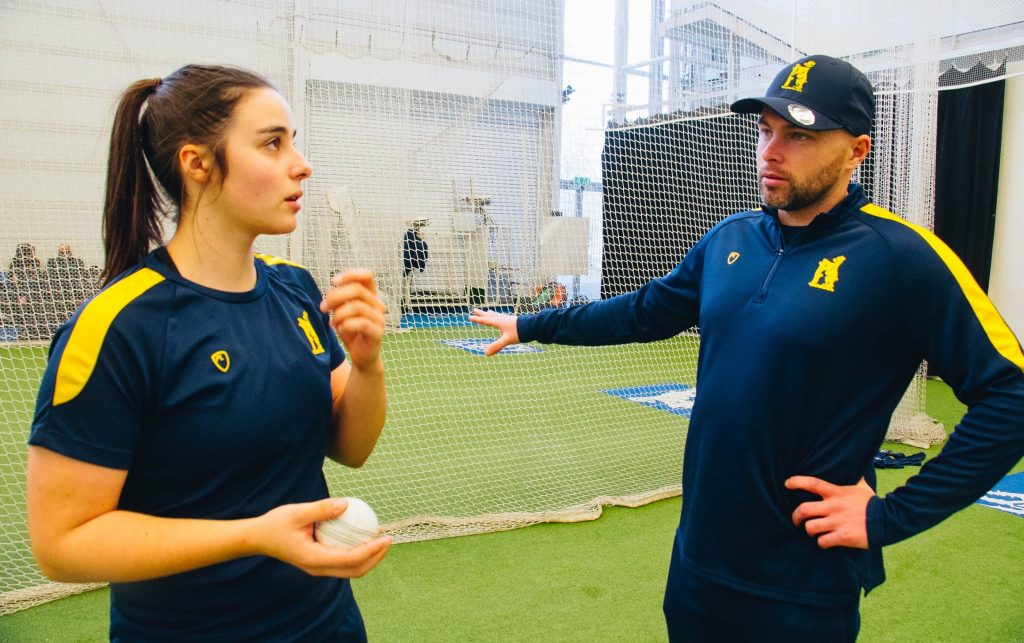
Millie Taylor is unique in English women’s cricket. But the only left-arm wrist-spinner across all eight tier-one counties never had the benefit of a coach who bowled the same as her until recently.
Only three men in county cricket have the same action as Taylor: Freddie Heldreich, Tom Hinley and Jake Lintott. It is the latter who has spent the winter coaching the newly turned professional.
While Taylor was awarded her first contract at Warwickshire at the age of 19 last year as part of the revamped women’s domestic cricket structure, Lintott took a different route. Instead of coming through an academy, he played at the lower levels of the game before being given a first professional deal in 2021 aged 27.
Faced with the prospect of a winter in the nets at Edgbaston, he decided to use his expertise to lend a hand with the women’s side, and has already had an impact. Taylor, who has moved more than three hours away from home to Birmingham and left her twin, Mary, who plays for Hampshire, is quick to point out the benefits of learning from someone who has the same unorthodox action as her.
“Having Jake in with me every Monday and bowling and batting, I think that just helps out a lot because I didn’t necessarily have specialist spin coaching previously. Now I do it’s a whole different experience,” Taylor tells Telegraph Sport, sitting on the balcony above the nets at Edgbaston before the pair start one of their regular sessions.
“I can ask questions and get answers referring to left-arm leg-spin. I know it’s strange because you could say that any spin coach could tell you that – but any spin coach could tell me that but would never have experienced it. So Jake can tell me that having experienced it, so I almost trust him a little bit more.”
Although not coaching on a formal basis, Lintott’s role has been organised with head coach Alistair Maiden, and he has already noticed a difference.
“I’ve played a lot of cricket and being able to pass that on I think helps,” Lintott says. “Because that’s half the battle, the tactical side of it, actually knowing what things and skills to have, what balls to bowl when and things like that.
“So it’s been good fun. We’ve had fun with the googly trying to get that. It’s such a good weapon for left-arm wrist-spin, so we’ve been working away at that and hopefully by the summer we’ll have it pretty much there to put it into practice.”
Enlisting senior male professionals to help nurture young female talent is uncommon in cricket, but it is not the only step Warwickshire have taken to integrate the two teams for the new season. The club have spent almost £250,000 in the build-up to this season on developing the old umpires’ boxes in an entire stand to suit the new women’s team. There is a new changing room, gym, hangout area and physio room just for the women.
Warwickshire are not the only county to have spent money developing a new women’s changing room and gym to give the side a permanent home and prevent a scramble for equipment – Surrey have also been building new facilities before the new season – but their American football-style dressing room has clearly had thought put into it. Each player has a cubby hole with their name on it, written graffiti-style in the blue and yellow colours of the side, while it is a big open room with a large table in the middle.

For Laura MacLeod, a former England cricketer and the head of high performance for Bears Women, the new system is an exciting prospect. But she is also open about the limitations of some of the younger players and their current abilities.
Despite minimum starting salaries for men and women being equal in domestic cricket from 2025, some younger women’s players have had fewer opportunities to develop their talents and have been limited to just two training sessions a week in an academy.
When asked how much of a difference this system can make for the depth of domestic cricket and feeding into the England set-up, which is now under the charge of her former team-mate Charlotte Edwards, MacLeod says: “With [Central] Sparks [the previous team in the West Midlands] we got a massive amount of support from this club in terms of access to facilities, but we’ve gone up; we’ve not gone up a notch, we’ve gone up a massive amount now.
“I suppose in the high-performance environment you talk about – or the British Cycling team talk about marginal gains – it’s not marginal gains, it’s not one per centers here, you’ve got 18-year-olds, 20-year-olds, that their training age, their maturity age is nowhere near and therefore they’ve got 10, 20 30 per cent differences to make.
“That’s the really exciting bit that you can see and the journeys that some of these have gone on, and I suppose it’s multi-faceted because it’s the physical, it’s the mental, it’s the skills as well.”
For Warwickshire, the challenge now is to translate the investment and developments off the field into success on the pitch.
Revamped domestic structure explained
After undergoing three revolutions in eight years, the new-look women’s county cricket season gets under way this month. Here, Telegraph Sport breaks down the new tiers and the three white-ball competitions they will play in.
Tier one The Blaze, Durham, Essex, Hampshire, Lancashire, Somerset, Surrey, Warwickshire.
Tier two Derbyshire, Glamorgan, Gloucestershire, Kent, Leicestershire, Middlesex, Northamptonshire, Sussex, Worcestershire, Yorkshire.
Metro Bank One Day Cup
Format 50-over competition
Who competes Tiers one and two
Start date Tier one: April 23 – Surrey v Somerset. Tier two: April 19 – Yorkshire v Worcestershire.
Finals Day Tier one: September 21, Utilita Bowl, Southampton. Tier two: September 14, New Road, Worcester.
Vitality Blast
Format T20 competition
Who competes Tiers one and two
Start date Tier one: May 30 – Hampshire v Essex. Tier two: May 29 – Middlesex v Sussex.
Finals Day Tier one: July 27, Kia Oval. Tier two: July 26, Northampton.
Vitality County Cup
Format T20 competition
Who competes Tiers one, two and three
Start date May 5 – Middlesex v Kent, Radlett.
Finals day May 26, Taunton.
Women’s county cricket predictions
Metro Bank One Day Cup
Tier-one winner: Lancashire
Only Lancashire and Surrey will have 21 women’s players in their squads, and Lancashire will have eight matches at Old Trafford, including four double-headers. The squad have received investment and they have a number of younger players in the England pathway, as well as experience.
Tier-two winner: Yorkshire
After signing Lauren Winfield-Hill and in their only season outside the top tier, it is hard to look past Yorkshire. They should, with their financial spending that included a pre-season tour, have the depth to come out on top, especially in the 50-over competition.
Women’s Blast
Tier-one winner: Surrey
With a squad including four England internationals, as well some experienced domestic cricketers, Surrey have invested in both their backroom staff and team. With a 21-player squad they have a strength in depth that will be hard to match by any of the other counties.
Tier-two winner: Glamorgan
Poised to join the top tier in 2027, Glamorgan have developed a strategic partnership with Gloucestershire, who are lending players to their rivals. They will also be coached by former New Zealand international Rachel Priest and will want to have two impressive seasons before moving up.
Vitality County Cup
Winner: Hampshire
Southern Vipers were the dominant force in the regional era of women’s cricket and they will have four England players in their squad. After going trophyless last season they are likely to fight back and compete for silverware, and what would be more coveted than the newest trophy?
Player of the season
Alice Davidson-Richards (Surrey)
As someone who is likely to play in almost every single match across the formats, Davidson-Richards will have plenty of chances to score runs. She was the top run-scorer in the Rachael Heyhoe Flint Trophy last season and is a useful bowling option.
Emerging talent
Davina Perrin (Warwickshire)
An 18-year-old who played her first games in the Hundred last season and spent the winter with England Under-19s, Perrin is poised to make an impact in 2025. Having been called up to the England A side for the four-day match against Australia following an injury to Freya Kemp, it is clear that she is highly rated.

Millie Taylor is unique in English women’s cricket. But the only left-arm wrist-spinner across all eight tier-one counties never had the benefit of a coach who bowled the same as her until recently.
Only three men in county cricket have the same action as Taylor: Freddie Heldreich, Tom Hinley and Jake Lintott. It is the latter who has spent the winter coaching the newly turned professional.
While Taylor was awarded her first contract at Warwickshire at the age of 19 last year as part of the revamped women’s domestic cricket structure, Lintott took a different route. Instead of coming through an academy, he played at the lower levels of the game before being given a first professional deal in 2021 aged 27.
Faced with the prospect of a winter in the nets at Edgbaston, he decided to use his expertise to lend a hand with the women’s side, and has already had an impact. Taylor, who has moved more than three hours away from home to Birmingham and left her twin, Mary, who plays for Hampshire, is quick to point out the benefits of learning from someone who has the same unorthodox action as her.
“Having Jake in with me every Monday and bowling and batting, I think that just helps out a lot because I didn’t necessarily have specialist spin coaching previously. Now I do it’s a whole different experience,” Taylor tells Telegraph Sport, sitting on the balcony above the nets at Edgbaston before the pair start one of their regular sessions.
“I can ask questions and get answers referring to left-arm leg-spin. I know it’s strange because you could say that any spin coach could tell you that – but any spin coach could tell me that but would never have experienced it. So Jake can tell me that having experienced it, so I almost trust him a little bit more.”
Although not coaching on a formal basis, Lintott’s role has been organised with head coach Alistair Maiden, and he has already noticed a difference.
“I’ve played a lot of cricket and being able to pass that on I think helps,” Lintott says. “Because that’s half the battle, the tactical side of it, actually knowing what things and skills to have, what balls to bowl when and things like that.
“So it’s been good fun. We’ve had fun with the googly trying to get that. It’s such a good weapon for left-arm wrist-spin, so we’ve been working away at that and hopefully by the summer we’ll have it pretty much there to put it into practice.”
Enlisting senior male professionals to help nurture young female talent is uncommon in cricket, but it is not the only step Warwickshire have taken to integrate the two teams for the new season. The club have spent almost £250,000 in the build-up to this season on developing the old umpires’ boxes in an entire stand to suit the new women’s team. There is a new changing room, gym, hangout area and physio room just for the women.
Warwickshire are not the only county to have spent money developing a new women’s changing room and gym to give the side a permanent home and prevent a scramble for equipment – Surrey have also been building new facilities before the new season – but their American football-style dressing room has clearly had thought put into it. Each player has a cubby hole with their name on it, written graffiti-style in the blue and yellow colours of the side, while it is a big open room with a large table in the middle.

For Laura MacLeod, a former England cricketer and the head of high performance for Bears Women, the new system is an exciting prospect. But she is also open about the limitations of some of the younger players and their current abilities.
Despite minimum starting salaries for men and women being equal in domestic cricket from 2025, some younger women’s players have had fewer opportunities to develop their talents and have been limited to just two training sessions a week in an academy.
When asked how much of a difference this system can make for the depth of domestic cricket and feeding into the England set-up, which is now under the charge of her former team-mate Charlotte Edwards, MacLeod says: “With [Central] Sparks [the previous team in the West Midlands] we got a massive amount of support from this club in terms of access to facilities, but we’ve gone up; we’ve not gone up a notch, we’ve gone up a massive amount now.
“I suppose in the high-performance environment you talk about – or the British Cycling team talk about marginal gains – it’s not marginal gains, it’s not one per centers here, you’ve got 18-year-olds, 20-year-olds, that their training age, their maturity age is nowhere near and therefore they’ve got 10, 20 30 per cent differences to make.
“That’s the really exciting bit that you can see and the journeys that some of these have gone on, and I suppose it’s multi-faceted because it’s the physical, it’s the mental, it’s the skills as well.”
For Warwickshire, the challenge now is to translate the investment and developments off the field into success on the pitch.
Revamped domestic structure explained
After undergoing three revolutions in eight years, the new-look women’s county cricket season gets under way this month. Here, Telegraph Sport breaks down the new tiers and the three white-ball competitions they will play in.
Tier one The Blaze, Durham, Essex, Hampshire, Lancashire, Somerset, Surrey, Warwickshire.
Tier two Derbyshire, Glamorgan, Gloucestershire, Kent, Leicestershire, Middlesex, Northamptonshire, Sussex, Worcestershire, Yorkshire.
Metro Bank One Day Cup
Format 50-over competition
Who competes Tiers one and two
Start date Tier one: April 23 – Surrey v Somerset. Tier two: April 19 – Yorkshire v Worcestershire.
Finals Day Tier one: September 21, Utilita Bowl, Southampton. Tier two: September 14, New Road, Worcester.
Vitality Blast
Format T20 competition
Who competes Tiers one and two
Start date Tier one: May 30 – Hampshire v Essex. Tier two: May 29 – Middlesex v Sussex.
Finals Day Tier one: July 27, Kia Oval. Tier two: July 26, Northampton.
Vitality County Cup
Format T20 competition
Who competes Tiers one, two and three
Start date May 5 – Middlesex v Kent, Radlett.
Finals day May 26, Taunton.
Women’s county cricket predictions
Metro Bank One Day Cup
Tier-one winner: Lancashire
Only Lancashire and Surrey will have 21 women’s players in their squads, and Lancashire will have eight matches at Old Trafford, including four double-headers. The squad have received investment and they have a number of younger players in the England pathway, as well as experience.
Tier-two winner: Yorkshire
After signing Lauren Winfield-Hill and in their only season outside the top tier, it is hard to look past Yorkshire. They should, with their financial spending that included a pre-season tour, have the depth to come out on top, especially in the 50-over competition.
Women’s Blast
Tier-one winner: Surrey
With a squad including four England internationals, as well some experienced domestic cricketers, Surrey have invested in both their backroom staff and team. With a 21-player squad they have a strength in depth that will be hard to match by any of the other counties.
Tier-two winner: Glamorgan
Poised to join the top tier in 2027, Glamorgan have developed a strategic partnership with Gloucestershire, who are lending players to their rivals. They will also be coached by former New Zealand international Rachel Priest and will want to have two impressive seasons before moving up.
Vitality County Cup
Winner: Hampshire
Southern Vipers were the dominant force in the regional era of women’s cricket and they will have four England players in their squad. After going trophyless last season they are likely to fight back and compete for silverware, and what would be more coveted than the newest trophy?
Player of the season
Alice Davidson-Richards (Surrey)
As someone who is likely to play in almost every single match across the formats, Davidson-Richards will have plenty of chances to score runs. She was the top run-scorer in the Rachael Heyhoe Flint Trophy last season and is a useful bowling option.
Emerging talent
Davina Perrin (Warwickshire)
An 18-year-old who played her first games in the Hundred last season and spent the winter with England Under-19s, Perrin is poised to make an impact in 2025. Having been called up to the England A side for the four-day match against Australia following an injury to Freya Kemp, it is clear that she is highly rated.











